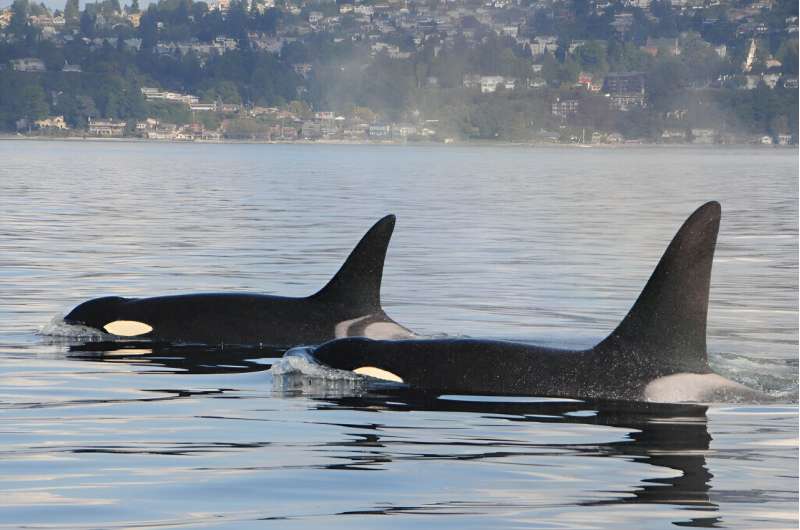This article has been reviewed according to Science X's editorial process and policies. Editors have highlighted the following attributes while ensuring the content's credibility:
fact-checked
peer-reviewed publication
trusted source
proofread
Toxic chemicals found in oil spills and wildfire smoke detected in killer whales

Toxic chemicals produced from oil emissions and wildfire smoke have been found in muscle and liver samples from Southern Resident killer whales and Bigg's killer whales.
A study published today in Scientific Reports is the first to find polycyclic aromatic hydrocarbons (PAHs) in orcas off the coast of British Columbia, as well as in utero transfer of the chemicals from mother to fetus.
"Killer whales are iconic in the Pacific Northwest—important culturally, economically, ecologically and more. Because they are able to metabolically process PAHs, these are most likely recent exposures. Orcas are our canary in the coal mine for oceans, telling us how healthy our waters are," said senior author Dr. Juan José Alava, principal investigator of the UBC Ocean Pollution Research Unit and adjunct professor at Simon Fraser University.
PAHs are a type of chemical found in coal, oil and gasoline, which research suggests are carcinogenic, mutagenic, and have toxic effects on mammals. Their presence in the ocean comes from several sources, including oil spills, burning coal and forest fire smoke particles.
Researchers analyzed muscle and liver samples from six Bigg's—or transient—killer whales and six Southern Resident killer whales (SRKWs) stranded in the northeastern Pacific Ocean between 2006 and 2018. They tested for 76 PAHs and found some in all samples, with half the PAHs appearing in at least 50% of the samples.
One compound, a PAH derivative called C3-phenanthrenes/anthracenes, accounted for 33% of total contamination across all samples. These forms of PAHs, known as alkylated PAHs, are known to be more persistent, toxic, and to accumulate more in the bodies of organisms or animals than parental PAHs.
No one has studied PAHs in killer whales in B.C. before. However, the researchers noted the average level of contamination in their study was lower than previous studies of cetaceans in the Gulf of California, and almost two times higher than that found in blood samples of captive killer whales from Icelandic waters.
SRKW contaminants largely from human emissions
The contaminants in Bigg's killer whales were mostly those produced by burning coal and vegetation, as well as forest fires. In SRKWs, they were the kind produced by oil spills and burning of fossil fuels like gasoline. The researchers say this could be due to the animals' differing habitats. Bigg's killer whales range from California to southeastern Alaska and into the North Pacific Ocean, while SRKWs stay closer to more polluted urban environments around the Salish Sea.
Feeding preferences, behavior and metabolism could also impact the amount of contaminants accumulating in the animals.
"B.C.'s coast is experiencing oil pipeline developments, oil tanker traffic, industrial effluents, forest fires, stormwater runoff and wastewater," said first author Kiah Lee, who conducted the work as an undergraduate student at UBC's Institute for the Oceans and Fisheries (IOF) and is now a masters student at the University of Oslo. "These activities put toxic PAHs into the marine food web and, as we saw here, they can be found in orcas, the apex predator."
Improve pollution management
"There's only a small population to draw from—74 individuals in the case of the Southern Residents," said co-author Dr. Stephen Raverty, IOF adjunct professor and veterinary pathologist with the B.C. Ministry of Agriculture and Food. "There are many potential causes for their decline, pollution being one."
One of the whales examined was "Luna," an orca separated from his mother as a calf, who had extensive human contact and lived in variable habitats, which may be why Luna showed a mixture of hydrocarbon contaminants.
"The preliminary findings from this study will add key information to inform management approaches in killer whale habitats," said Paul Cottrell of Fisheries and Oceans Canada. "The source of the PAHs is often from human activity and it is important we have baseline data on current PAH levels in killer whales to monitor those trends and impacts in marine ecosystems into the future."
Ultimately, humans need to reduce and eventually eliminate fossil fuel consumption to help combat climate change and conserve marine biodiversity, said Dr. Alava. "This would also serve to bolster the resilience and health of marine ecosystems, benefiting communities that rely on them such as coastal First Nations peoples as well as future generations."
More information: Kiah Lee et al, Polycyclic aromatic hydrocarbon (PAH) source identification and a maternal transfer case study in threatened killer whales (Orcinus orca) of British Columbia, Canada, Scientific Reports (2023). DOI: 10.1038/s41598-023-45306-w
Journal information: Scientific Reports
Provided by University of British Columbia


















